Salford
Explore hidden histories, historic photos, and things you never knew about Salford from the collections and archives of Historic England.
Discover your local listed buildings and places
Introducing some of Salford's most historic sites, included in the National Heritage List for England. Some of these captions have been summarised by AI. Click through for the official List entry. Skip this section and go to place by numbers
Buile Hill Park
Salford
Buile Hill Park, a historical public park in Salford, features areas from Seedley Park, Buile Hill house, Springfield, and Hart Hill estate, with rich historical development from 1827 to...
Peel Park
Salford
A municipal urban public park, planned in 1845 by Joshua Major and opened in 1846, altered in the C20 and refurbished in 2017.The paved terrace outside the Maxwell Building, the access road...
Ordsall Hall
Salford
Ordsall Hall, a significant early 16th-century house with 17th-century and later additions, features timber framing and historical interior elements like the 'Star chamber' with its ornate...
Coach & Horses public house, 350 Eccles New Road, Salford
Salford
Public house, 1913. A rare example of a virtually intact Edwardian suburban pub building.
Statue of Joseph Brotherton
Salford
A statue of 1858 by Matthew Noble, cast in bronze by Robinson and Cottam of Pimlico and funded by public subscription, with a granite plinth of 2018.
Mural at Former Cromwell Secondary School
Salford
Relief mural depicting a stylised 'Tree of Knowledge', 1962, by Alan Boyson, ceramic and concrete with red tiles and pebbles, approximately 7m by 7m.
Church of St Augustine
Pendlebury and Clifton
The Church of St Augustine, built in 1871-4 by G. F. Bodley, showcases Free Gothic style with a richly detailed interior and intricate roof design.
Church of St Mary
Eccles
St Mary Church in Eccles, a medieval structure, showcases 13th-century elements, significant 15th-century extensions, and notable features like its coffered nave roof and historical...
Stanley Arms, Eccles
Eccles
Public house, late-C19, remodelled c1910. Red brick, slate roof, 3-storeys. Incorporates an attached 2-storey, late-C19 former terraced house.
Three Totem Sculptures in Front Courtyard of the Allerton…
Salford
Three concrete totem sculptures, 1966, by William Mitchell for the forecourt of the contemporary Allerton Building by Halliday Meecham. Salford Technical College now University of Salford.
Lime kiln and associated culvert 50m north of Worsley Met…
Worsley
A disused twin-pot lime kiln, and culvert over the Worsley Brook, dating from around 1770 and surviving as an earth mound with buried remains, brick and stone tunnels and standing brick and...
Weaste Cemetery
Salford
A public cemetery opened in 1857 and extended in 1887-8 by the Borough Engineer, Arthur Jacob, with planting by Henry Moore, head gardener at Peel Park.
Bridgewater Canal's Barton Aqueduct embankment and retain…
Eccles
The surviving section of James Brindley's Barton Aqueduct (1760-1761), consisting of the raised, embanked section of the Bridgewater Canal that extended between the bridging sections across...
Former Victoria Theatre, Salford
Salford
A former variety and touring production theatre of 1899 by Bertie Crewe, with Baroque red terracotta façade with alterations.
The Bothy
Worsley
Boiler-house and gardeners' dormitory of the early 1840s by Edward Blore, of buff Hollington stone and red brick and with the chimney given the appearance of a beacon tower or lighthouse.
Barton Lane Aqueduct Portal
Eccles
Canal aqueduct portal, built between 1822 and 1824 for the Bridgewater Canal Company.
Andrew Knowles and Sons Collieries War Memorial
Pendlebury and Clifton
First World War memorial of 1919.
Explore more
Search for more listed placesSalford through time
This timeline shows the first period of use for buildings and places on the National Heritage List for England, just one of the details recorded for every list entry. Click around to see how Salford changes over time. Skip this section and go to aerial photos
Prehistoric Before AD 43
Prehistory covers a million years of human occupation before the Roman invasion, from hunter-gatherers of several human species, including Neanderthals, to more recent herders and farmers. It was a time of developing technologies and belief systems, involving contact with and migration from Europe, all reflected in the variety of artefact and monument types characteristic of particular prehistoric periods.
We don't have an image for any of these list entries yet
Medieval AD 1066 to AD 1540
This period, sometimes known as the Middle Ages, began with the Norman invasion in AD 1066. It saw a significant rise in military and defensive buildings such as castles and earthworks, as well as religious houses dominating a largely agricultural landscape.
The monarchy and Church dominated the period, which also saw the break with the Roman Catholic Church and the English reformation.
Post medieval AD 1540 to AD 1901
The Post-Medieval period brought seismic changes to life in England, with religious reformation leading to the democratization of worship and the destruction of hundreds of religious houses.
In parallel, there was a huge expansion of scientific study and enlightenment that permanently altered the nation's social structure and landscape. Industrialization and mass production lead to wider global trade, emigration, and immigration.
20th century AD 1901 to AD 2000
The 20th century saw an incredible expansion of England's transport networks, with suburban growth shadowing rapid infrastructural expansion. The establishment of state schools, hospitals, and modern technical colleges, with new architectural styles, radically changed the appearance of towns and cities.
Two catastrophic world wars and the 1918 pandemic also brought unprecedented change, altering England's built environment and social structures forever.
Prehistoric Before AD 43
Prehistory covers a million years of human occupation before the Roman invasion, from hunter-gatherers of several human species, including Neanderthals, to more recent herders and farmers. It was a time of developing technologies and belief systems, involving contact with and migration from Europe, all reflected in the variety of artefact and monument types characteristic of particular prehistoric periods.
We don't have an image for any of these list entries yet
Medieval AD 1066 to AD 1540
This period, sometimes known as the Middle Ages, began with the Norman invasion in AD 1066. It saw a significant rise in military and defensive buildings such as castles and earthworks, as well as religious houses dominating a largely agricultural landscape.
The monarchy and Church dominated the period, which also saw the break with the Roman Catholic Church and the English reformation.
Post medieval AD 1540 to AD 1901
The Post-Medieval period brought seismic changes to life in England, with religious reformation leading to the democratization of worship and the destruction of hundreds of religious houses.
In parallel, there was a huge expansion of scientific study and enlightenment that permanently altered the nation's social structure and landscape. Industrialization and mass production lead to wider global trade, emigration, and immigration.
20th century AD 1901 to AD 2000
The 20th century saw an incredible expansion of England's transport networks, with suburban growth shadowing rapid infrastructural expansion. The establishment of state schools, hospitals, and modern technical colleges, with new architectural styles, radically changed the appearance of towns and cities.
Two catastrophic world wars and the 1918 pandemic also brought unprecedented change, altering England's built environment and social structures forever.
Aerial photos of Salford
Aerial photography helps reveal secrets of England's changing landscapes that are impossible to see from the ground. Skip this section and go to archive images
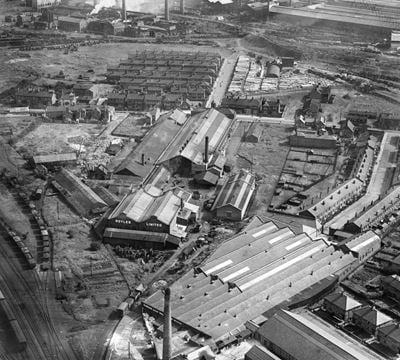
Irlam
The Royles Ltd Engineering Works and the Kinder and Co. Wallpaper Works, Irlam, 1931

Irlam
The Royles Ltd Engineering Works and the Basket Works and Picture Theatre off Liverpool Road, Irlam, 1931
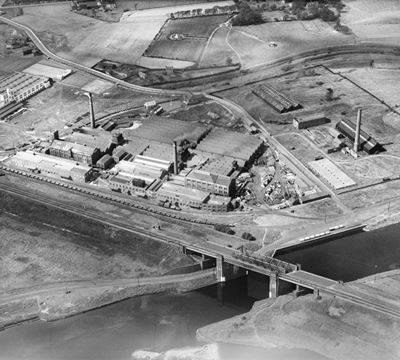
Irlam
The CWS Soap and Candle Works, Irlam, 1928
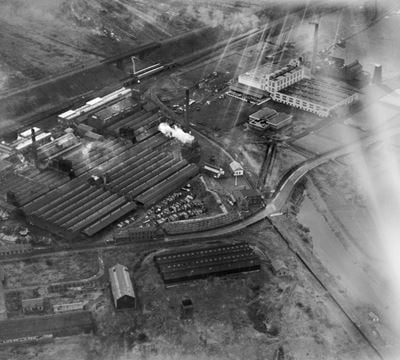
Irlam
The Co-Operative Wholesale Society Minerva Soap and Candle Works, Irlam, 1929

Irlam
The residential area at Eldon Road and Etherley Close, Irlam, 1937
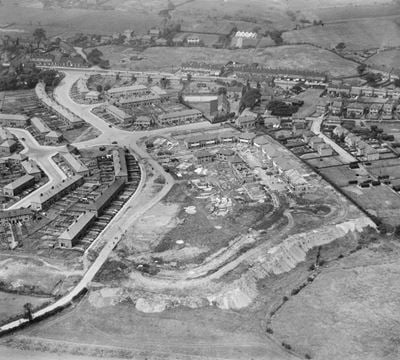
Irlam
The residential area at Harewood Road under construction, Irlam, 1937

Irlam
The Co-Operative Wholesale Society Lard Refinery and Margarine Works, Irlam, 1929

Irlam
The Co-operative Wholesale Society Ltd Margarine Works, Irlam, 1929

Salford
The Spillers Warehouse and Pomona Docks, Salford, 1923
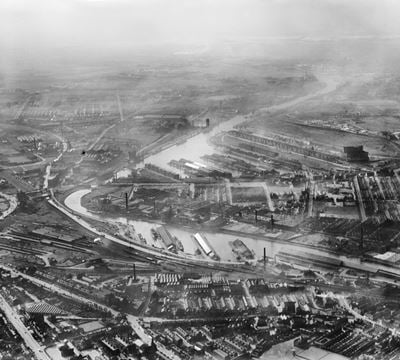
Salford
Manchester Docks, Salford, 1934
Salford in the Historic England Archive
The Historic England Archive cares for over 15 million images, dating from the 1850s to the present day. Discover stunning images of Salford's past. Skip this section and go to stories about heritage
Eric de Mare
Barton Upon Irwell, Salford
Date created: circa 1950s
General view from the south showing the Barton Swing Aqueduct carrying the Bridgewater Canal over the Manchester Ship Canal.
John Laing Collection
Salford
Date created: 1992
Interior view of office lobby as part of the Exchange Quay development in Salford
London, Midland and Scottish Railway Company
Salford
Date created: 16 Nov 1927
The interior of the Carr's depot at Salford Goods Station, showing boxes of biscuits stacked under the barrel-vaulted roof
Nigel Temple Collection of Postcards of Parks and Gardens
Irlam, Salford
Date created: 1900 - 1920
GENERAL VIEW SHOWING THE SUNKEN GARDEN IN PRINCES PARK
Eric de Mare
Davyhulme, Trafford
Date created: 1955
A view of a vessel on the Barton Swing Aqueduct, Greater Manchester.
John Laing Collection
Salford
Date created: 1992
View of the Exchange Quay development in Salford showing the Trafford Road Bridge in the foreground
London, Midland and Scottish Railway Company
Salford
Date created: 16 Nov 1927
A wagon loaded with construction materials, outside the entrance to the depot of Rownson, Drew and Clydesdale Ltd at Salford Goods Station
Nigel Temple Collection of Postcards of Parks and Gardens
Salford
Date created: 1900 - 1930
EXTERIOR VIEW SHOWING STATUES IN FOREGROUND
Eric de Mare
Davyhulme, Trafford
Date created: 1955
A view of a barge crossing the Barton Swing Aqueduct, Greater Manchester.
London, Midland and Scottish Railway Company
Salford
Date created: 16 Nov 1927
Boxes of self-raising flour and suet in the barrel-vaulted depot of the Macdougall Brothers, at Salford Goods Station
Nigel Temple Collection of Postcards of Parks and Gardens
Peel Park, Salford, Salford
Date created: 01 Jan 1900 - 03 Apr 1905
EXTERIOR VIEW WITH STATUE IN FOREGROUND
London, Midland and Scottish Railway Company
Salford
Date created: 16 Nov 1927
A man moving a ceramic toilet in the barrel-vaulted depot of Rowson, Drew and Clydesdale at Salford Goods Station, with fireplaces, sinks and other...
Stories about heritage in your local area
Historic England publishes news, blogs, research, videos, and podcasts celebrating England's rich heritage. Discover the stories we have about Salford. Skip this section and go to education
The Gallipoli Campaign: 7 War Memorials That Bear Witness to the Great Loss
Mentions Lancashire Fusiliers Memorial
Poignant reminders of the sacrifices made during the Gallipoli campaign of the First World War.
The Empire Theatre, Burnley
Mentions Salford
Unearthing a hidden gem: research into the Burnley Empire aims to raise awareness and inform potential reuse of the building.
Historic Character and Good Design
Mentions Salford
Article exploring how historic character is a positive force in building distinctive, better designed, places.
Pioneering Peel Park Protected and Joseph Brotherton Statue Listed
Mentions Peel Park, Statue of Joseph Brotherton, Salford
One of the first free municipal public parks in a major industrial city and a statue of Joseph Brotherton MP have been listed at Grade II by DCMS.
Heritage at Risk in the North West Revealed
Mentions Church of the Ascension, Salford
3 sites have been saved and 6 sites added to the Heritage at Risk Register 2023 in the North West of England.
New Funding to Champion England’s Working-Class Heritage
Mentions Salford
Historic England announces further funding to uncover the stories of working-class people and places often missing from the history records.
Historic England Celebrates Ukrainian Heritage With New Listings in the North Ahead of Eurovision
Mentions Ukrainian Catholic Church of the Dormition of The Holy Mary Mother Of God, and associated boundary walls and gate piers, Salford
Celebrating how the people of Ukraine have helped shape our nation over many generations.
War Memorials Listed Ahead of Armistice Day
Mentions Irlam and Cadishead War Memorial, Salford
First World War memorials in England have been listed ahead of Armistice Day. Many of them also commemorate those lost during the Second World War.
Government Pilot Scheme Helps Protect 396 Listed Places of Worship
Mentions Monton Unitarian Church, Church of St Mary, Salford
A £1.8 million scheme funded by the DCMS and run by Historic England, has helped 396 listed places of worship during its two-year period.
Heritage at Risk 2018
Mentions Church of St Luke
Historic England unveils latest chapter in the fight to save important heritage in 20th year of the national Register.
Historic England invites people to see and hear the 'Spirit of the North'
Mentions Salford
New photographs by John Kippin for Historic England explore the ‘Spirit of the North’
Overwhelming Public Support for Saving England’s Mills Revealed
Mentions Salford
Historic England calls for industrial mill buildings to be at the centre of regeneration
Salford's social history through photos
Over 10,000 images from the Historic England Archive have been specially selected and re-captioned for teachers, students, and anyone who wants to learn more about their local area. Skip this section and go to grant-aided places
Worsley Old Hall, Worsley, Greater Manchester
Period: Stuart (1603 - 1713)
Worsley Old Hall is a low two storied building partly timber framed and partly of brick. It dates from the 17th century.
Worsley Old Hall, Worsley, Greater Manchester
Peel Park, Salford, Greater Manchester
Period: Edwardian (1902 - 1913)
Peel Park is said to be possibly the world's first Public Park. It opened on 22 August 1846.
Peel Park, Salford, Greater Manchester
Tags
Modern sterilising and scrubbing-up equipment, Hope Hospital, Salford, Greater Manchester
Period: World War Two (1939 - 1945)
The 'modern' sterilising and scrubbing-up equipment between the operating theatres at Hope Hospital in 1940.
Modern sterilising and scrubbing-up equipment, Hope Hospital, Salford, Greater Manchester
Mark Addy Memorial, Cemetery Road, Salford, Greater Manchester
Period: Victorian (1837 - 1901)
This is a memorial to Mark Addy. It was built in 1890-91 and paid for by the people of Salford. In May 1891 1,000 people attended it's unveiling.
Mark Addy Memorial, Cemetery Road, Salford, Greater Manchester
Lamb Hotel, Regent Street, Eccles, Greater Manchester
Period: Edwardian (1902 - 1913)
This pub was built in 1906 by Mr Newton of Hartley, Hacking & Co., for Holt's Brewery.
Lamb Hotel, Regent Street, Eccles, Greater Manchester
Tags
Kersal Cell, Littleton Road, Salford, Greater Manchester
Period: Tudor (1485 - 1602)
This 16th century timber framed manor house is on the site of the 12th century Cluniac priory.
Kersal Cell, Littleton Road, Salford, Greater Manchester
Kenyon Peel Hall, Little Hulton, Greater Manchester
Period: Victorian (1837 - 1901)
The exterior of Kenyon Peel Hall with wooden beams acting as shoring to support the walls.
Kenyon Peel Hall, Little Hulton, Greater Manchester
Tags
Islington Mill, James Street, Salford, Greater Manchester
Period: Georgian (1714 - 1836)
This cotton spinning mill was built in 1823 by David Bellhouse of Manchester.
Islington Mill, James Street, Salford, Greater Manchester
Discover more
Ready for more local stories? Take a look at these other places nearby


